As forecasted, the winds have let up, allowing the rope team to continue fixing it to the summit. This will open the mountain for scores for clients with one or more Sherpas in support. Look for a busy first wave of summits over the next few days.
Big Picture
The question is, how many people will be on their summit push this weekend? Almost every team has completed their acclimatization programs and is ready. The lack of fixed rope to the summit and high winds above Camp 3 has stalled everyone, frustrating some team leaders. Some forecasts have acceptable summit winds, under 30 mph/48 kph through May 20. If this pans out, there will be plenty of time for everyone to have their shot at the top. Thus, it becomes an opportunity for the team leaders to cooperate and coordinate their summit pushes.
Nepal issued 467 permits, and each foreigner, aka client or member, has at least one Sherpa climbing with them. Some have two or more. Last year’s final statistics showed 683 summits on the Nepal side broken down as 256 members and 415 Sherpas in support, yielding a ratio of 1: 1.62. By the way, for members, 75% of those who climbed above base camp made the summit.
According to the Himalayan Database, the top reasons for ending a climb once above base camp are:
- Exhaustion, frostbite, Weakness or Lack of Motivation
- Other Illnesses or Pain
- Bad Weather (storms, high winds, etc.)
In a typical year, around 25% of the clients abandon their expedition. Some get hurt, others are bored, and some figure out they are in over their head and wisely return home, hoping, perhaps, to learn from this experience and return one day better prepared. If that holds for 2023, we’ll see around 350 members instead of 467, making the crowds more manageable.
As the winds let up, almost as a final kiss, high winds knocked down many tents at Camp 2 over the last few days. No one was injured, but some tents were lost. The best teams have spares, while others go begging for replacements. Just another normal day on Everest!
One fly in the summit ointment is that Camp 4 at the South Col has not been established. By this time in a normal season, Sherpas have stocked it with ample supplies like tents, stoves, fuel and oxygen. Some teams will skip this first wave until it’s established, while others will have the Sherpas do double work by supporting their client and carrying huge loads. This is an example of how Sherpas are so critical to climbing Everest for practically every client.
Who Summits First?
There are about 44 teams on Everest, ranging from two people to 100. Almost without exception, all depend on Sherpas to establish camps, including ferrying food, fuel, tents, and supplemental oxygen.
While you may read about someone climbing “self-supported,” in reality, they are supported by the Icefall Doctors to set ropes and ladders in the Khumbu Icefall or to Advanced Base Camp on the North. Also, they get support from the rope team, who set the safety line to the summit. If they clip into someone else’s rope or step on a ladder, they are supported.
And some “independent” climbers depend on Sherpas to establish their camps, just like the commercial teams. This is not meant to criticize but to clarify and frame the problem. (well, maybe a slight criticism of their transparency and acknowledgment of the support they use)
#1 Fix Route

This is the deal; the tradition is that the Sherpa rope-fixing team is the first to summit Everest. While it is possible for someone to climb independently or without fixed ropes, it is rare. Perhaps we will see Kenton Cool do it this year. But even Kenton will use the ladders in the Khumbu Icefall, and he is fine with that. But that will be just him and perhaps his client and Sherpas, leaving 998 climbers to go!
#2 Acclimatize
Even though an average Everest expedition arrives at base camp in early April, all climbers must check off three items before they attempt to summit: wait for the ropes to be fixed, acclimatize by climbing to between 20,000 and 23,000 feet and have a weather forecast of four to seven days with winds under 30 mph.
#3 Good Weather
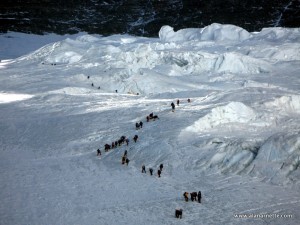
The weather forecast is the primary factor that drives the crowds. If there are only a few good weather days, everyone elbows to get their spot in line. The normal range is 6 to 16 days, with an average of 11 since 2001. In 2019, the year most talked about for crowds; it went down to three.
The best-case scenario for 2023 is for many good weather days to spread out the crowds. If it is like 2019, with three or even six, we can expect record deaths and record frostbite while seeing record summits – a harsh scenario.
Total Support
The picture often used as exhibit A in the trial of Everest’s overcrowding was from 2019, when a picture of a long line of people between the South Summit and Summit went viral. Another is from 2012, when Ralf Dujmovits captured a long line of Sherpas ferrying gear to the South Col.
The fact is that those Sherpas were carrying a large amount of oxygen to the Col, plus extra food, tents and supplies for members. The trend is for members to use four lpm of oxygen, where it used to be only two lpm, and now many use six and eight lpm making it easier for the members. Therein lies the problem with crowding – too many people with marginal skills requiring exorbitant support.
But I digress 🙂
Summit Strategies
More often than not, the summit push is a herd mentality based on rumors throughout the base camp of the forecast, sometimes based on false information planted by ill-intentioned teams.
There will be 1,000 humans on the flanks of Lhotse and Everest (South) starting this weekend week. If you are already there, what are your options? Here goes:
Get out Early
Once the ropes are fixed, and there is a good weather forecast, teams must gamble on when to begin the first summit attempt. By going first in early to mid-May, it is cold, very cold. And if the forecast misses the winds by 20%, it can be horrible. If the humidity spikes or an unexpected snow squall moves in, it can be common for hoarfrost to coat climbers making for a miserable summit experience, and once they get there, there is no view.
But this is the rub with this strategy; many teams want to be “first,” so it can be crowded. There can easily be 100 to 200 climbers in that first window. And to complicate matters, it seems the least experienced and sometimes slowest teams try to go early, creating a massive traffic jam. These teams refuse to step aside to let faster climbers pass; thus, a mass of humanity is paced by the slowest and sometimes the least capable climber on the mountain.
Despite Nepal’s claims of putting authorities at base camp in 2023, there is no “governing body” to control this, and calls for regulations have never been implemented. Guides will meet a few times during the season to try to coordinate, and some do, but many don’t cooperate, simply managing their summit push to their schedule without regard for anyone else.
Ok, so you have 300 people trying to be the first to summit in cold conditions at a snail’s pace. Not to despair; there is a solution to this. Hang on.
Go Late
This scenario calls for the team to be one of the last to go after everyone else has given it a go. In the notorious 2019 season, Mike Hamill’s Climbing the Seven Summits went on the last day of the season and had the mountain to themselves. Dave Hahn, who once held the non-Sherpa summit record with fifteen, used this strategy year after year and was very successful. The advantages are that the weather is usually the warmest of the season, the boot track is kicked in, and the crowds are gone. You can move fast and easily. And there is a huge “but”…
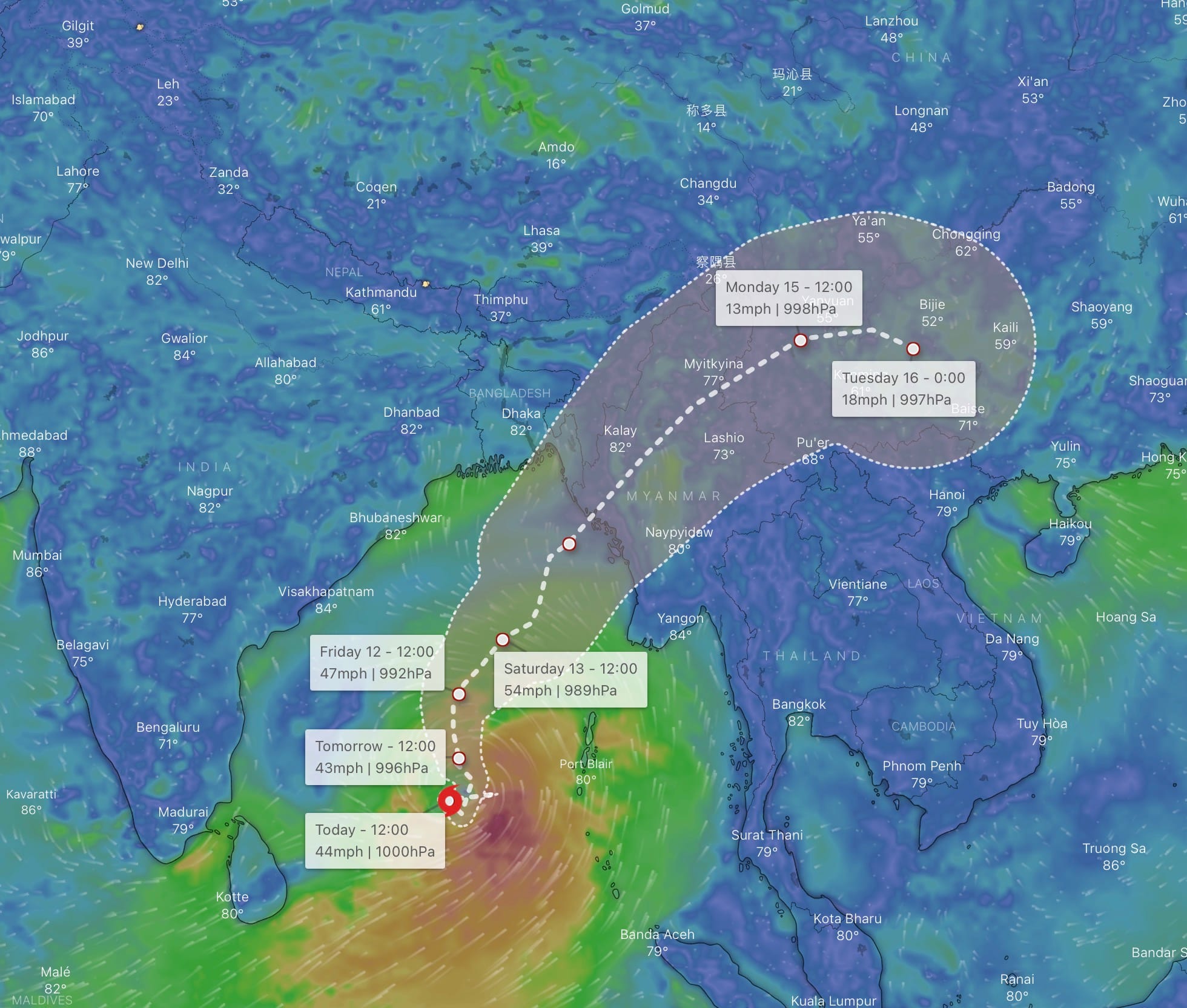
Weather forecasting on Everest has improved, but all it takes is for a cyclone to develop in the Bay of Bengal, bringing snow and winds to Everest, or the monsoons to start early, or the Jet Stream to move on top of the summit, or a hundred other variables and without warning, the season comes to an early halt.
Even with a forecast of an early end, all of a sudden, that four to seven-day window needed to summit drops to two or four days, and you gamble with your life. If you push during a small window, you must go fast, often foregoing that extra night at altitude to rest. You may need extra oxygen that you don’t have, but most of all, you must be in almost perfect health. This is not a scenario for novice, slow, inexperienced climbers. You can easily die. This is the most risky of all my options.
Goldilocks Timing
Each year, a few lucky teams go between the early and late teams when it is not too cold and not too hot (as if it ever is on Everest!) and the winds are low. In other words, perfect conditions. Most summits have occurred between 17-22 May since 1953. But this doesn’t mean the weather was good. Let me repeat this – just because more people summit on 19 May, does not mean the weather is always good that day each year.
As previously discussed, these teams chose to skip the early windows due to the crowds but didn’t want to wait too late and risk missing any windows altogether. So knowing May 19th has been the sweet spot for decades, many teams arbitrarily target this date.
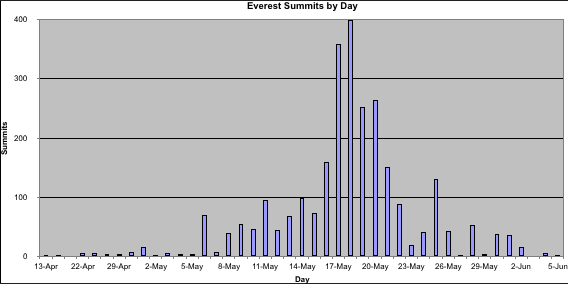
But with climate change, many of these historical patterns are not as predictive as they once were. Anyway, there are long time very experienced guides who will pour over custom weather forecasts and select a window based on their experience, advice from professional meteorologists and input from long-time Everest Sherpas on mountain conditions. You will rarely see a seasoned team go for the summit in bad weather, yet it occasionally happens.
Break into Small Sub Teams and Go Fast and Nimble
This is the strategy I like the best, but it is the hardest to achieve. You play your own game. You go when your mind and body are fully prepared. You are well rested, acclimatized and have all your camps stocked, and the weather looks good.
In 2023, there are teams with fifty members, plus fifty Sherpas – 100 total climbers! Some with even more. These large teams will break up into smaller teams of perhaps twenty to forty climbers in total, still a lot of people. This is an attempt to not “clog” the route.
 But some use a technique where they literally climb nose to butt. The theory is that they move as a single pod in unison, gathering strength from the group. This technique is fine if they were alone on the mountain, but the problem is this technique is almost always extremely slow and plodding, thus creating the bottlenecks we spoke of earlier.
But some use a technique where they literally climb nose to butt. The theory is that they move as a single pod in unison, gathering strength from the group. This technique is fine if they were alone on the mountain, but the problem is this technique is almost always extremely slow and plodding, thus creating the bottlenecks we spoke of earlier.
So the best way to deal with these clogs is to unclip from the fixed rope and pass them. Yes, you will assume the risk of slipping on ice or steep terrain and falling to your death, but you have to use common sense on where and in what conditions to make this move.
The key, however, is that you must have the flexibility to break away from your group. If your leader insists on you being a cog in the wheel, you are stuck. So discuss this scenario with your team before you leave base camp.
In 2011 I was with IMG and climbed with Kami Sherpa and no Western guide. Even though IMG has huge teams, they break them into sub-teams. In 2011 my team became very small for a variety of reasons; thus, we had great flexibility. I credit the IMG leadership for their flexibility and the IMG Sherpas for their skills and experience.
Kami and I made the “pass the clog” move as we left the South Col on 20 May 2011. There were forty to sixty people almost standing in place that night on the Triangular Face about 27,000 feet, just above the South Col or Camp 4. The weather was perfect, and the terrain was reasonable, not overly steep when we made our move. We passed over fifty people in one push.
That single decision allowed us to be the third and fourth person to summit that day from the south side out of 150 in total. We never waited during our entire summit push-up and back.
Choices
While I went thru several scenarios, often on Everest, your choices are limited due to your team leadership, mountain conditions, weather or your own skills.
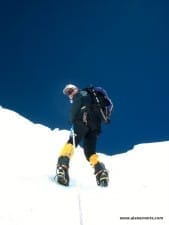 2023 will almost certainly be difficult. It may be the year that finally forces serious changes in the future. In any event, perhaps the only solution to avoid crowds altogether on either of the Everest commercial routes is to limit the number of people thru quotas similar to Denali or strict requirements to receive a permit, perhaps by requiring a summit of an 8000-meter mountain like is already done by the Chinese authorities for Chinese nationals.
2023 will almost certainly be difficult. It may be the year that finally forces serious changes in the future. In any event, perhaps the only solution to avoid crowds altogether on either of the Everest commercial routes is to limit the number of people thru quotas similar to Denali or strict requirements to receive a permit, perhaps by requiring a summit of an 8000-meter mountain like is already done by the Chinese authorities for Chinese nationals.
So what are your choices? Actually, there are several if you find all of this untenable.
First: climb in the Autumn when there is almost no one there. Yes, it takes stronger, faster, tougher, more experienced climbers, but…
Second: investigate different routes, like the West Ridge. Yes, it is harder and longer, your chances of summiting are less, and it takes more experienced climbers, but…
Third: climb on your own terms to go where and when you like. There are no rules that say you have to use the fixed ropes or ladders put in by the support teams. Yes, it would be more dangerous and require more skills and experience, but …
It is popular to complain about the crowds on Everest, more so by people who are not there, never have been and never will. For those that are there, complaining about the crowds is kind of like saying I don’t want to belong to any club that would have me as a member (thank you, Groucho Marx!).
In the end, we all have choices.
Climb On!
Alan
Memories are Everything
PS Thoughtful comments are welcome, but please not the old tired ones about climbers being idiots, closing the mountain or putting an escalator in. Counting on some thoughtful and constructive observations 🙂 Thanks.
Nepal RECORD Permit Update as of May 7, 2023
The permits for Everest are leveling out, albeit at a record of 467. The previous Everest record was 408 for the 2021 season of 408. Nepal issued climbing permits for 1,123 climbers from 80 countries for 27 peaks. Looking at Everest only, China has the largest representation with 96 members, followed by the US at 87, India–at 40, Canada-21, and Russia-20. There are 44 countries represented by three or fewer climbers.
These permits have generated $5.6M in royalties for the government. Almost all of this revenue stays in Kathmandu, with some in various personal pockets and none to the Sherpas, porters, or other high-altitude workers. The Nepal Ministry of Tourism posted these foreign permit tallies as of April 28, 2022:
- Everest: 467 on 44 teams
- Lhotse: 126 on 14 teams
- Ama Dablam: 79 on 8 teams
- Nuptse: 63 on 6 teams (only a few will attempt to summit, most will stop at C2)
- Makalu: 58 on 7 teams
- Annapurna I: 54 on 5 teams
- Kanchenjunga: 42 on 4 teams
- Himlung: 41 on 5 teams
- Dhaulagiri: 35 on 3 teams
- Manaslu: 15 on 4 teams
Climb On!
Alan
Memories are Everything
The Podcast on alanarnette.com
You can hear #everest2022 podcasts on Spotify, Apple Podcast, Google Podcasts, Pocket Casts, RadioPublic, Anchor, and more. Just search for “alan arnette” on your favorite podcast platform.
Summit Coach
If you dream of climbing mountains but are not sure how to start or reach your next level, from a Colorado 14er to Rainier, Everest, or even K2, we can help. Summit Coach is a consulting service that helps aspiring climbers throughout the world achieve their goals through a personalized set of consulting services based on Alan Arnette’s 25 years of high-altitude mountain experience, including summits of Everest, K2, and Manaslu, and 30 years as a business executive.

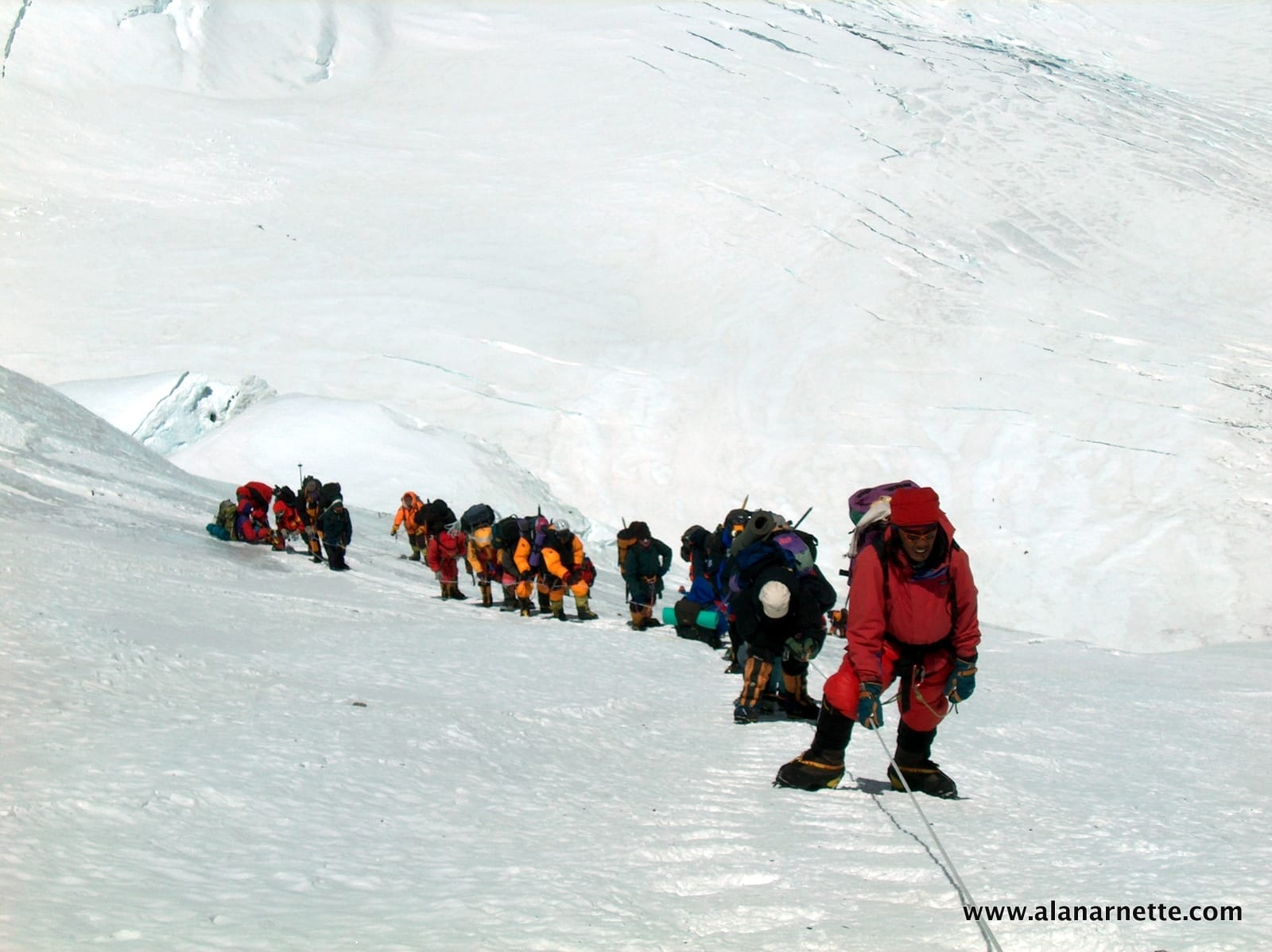




5 thoughts on “Everest 2023: Managing the Crowds this Weekend of Summits”
Thank you for the wonderful coverage, as always! Look forward to it every year!
I find Everest terrifying and fascinating in equal measures! I don’t have the mental strength to get me to the top but I love following it every year and your way with words makes me feel part of it so ty
Hi Alan! Have really been enjoying your Everest updates, I’m checking every night to see how close we are to a summit! I have recently become very interested in mountaineering and whilst I think it is something I will never do myself I am finding it absolutely fascinating. Thanks for the updates! 🙂 – M
Hey Alan great column! Like always, you have the best, most informative, neutral in opinion one out there in my opinion. Though I personally kinda miss the old scoreboard. This many folks on the hill would take one heck of a big scoreboard tho… I’m sorta interested in Nirmal Purja and Sadpara teaming up for a no O2 attempt. And I remember Ed Viesturs said everything has to be right for that to happen… crowded routes and traffic jams could throw a big wrench in it. Fingers crossed for everyone!
Thanks, Doug. Sadly, I’m finding that much of the information put on social, blogs, etc, is too promotional and doesn’t reflect reality. Yes, “I’m shocked, shocked to find that gambling is going on in here!” to quote Capitan Renault in Casabalnca!
Comments are closed.